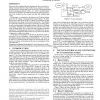Free Online Productivity Tools
i2Speak
i2Symbol
i2OCR
iTex2Img
iWeb2Print
iWeb2Shot
i2Type
iPdf2Split
iPdf2Merge
i2Bopomofo
i2Arabic
i2Style
i2Image
i2PDF
iLatex2Rtf
Sci2ools
GLVLSI
2010
IEEE
2010
IEEE
Overscaling-friendly timing speculation architectures
Processors have traditionally been designed for the worst-case, resulting in designs that have high yields, but are expensive in terms of area and power. Better-than-worst-case (BTWC) design approaches based on timing speculation (TS) [1, 2, 3, 4] have recently gained ground as an alternative to traditional designs by allowing processors to be designed for the average case and still maintain high yields. In this paper, we characterize the behavior of TS-based designs in the face of voltage overscaling [5] (or undervolting). We show that the power benefits of TS due to voltage overscaling are greatly determined by the design of the circuit architecture. The benefits are small if the underlying circuit has a small range of timing paths, as such circuits produce catastrophic failures in the face of voltage overscaling. Benefits may be limited even for circuits with a wide range of timing paths, due to short path and long path constraints imposed by TS techniques like Razor [1, 2] and ...
Related Content
| Added | 10 Jul 2010 |
| Updated | 10 Jul 2010 |
| Type | Conference |
| Year | 2010 |
| Where | GLVLSI |
| Authors | John Sartori, Rakesh Kumar |
Comments (0)

